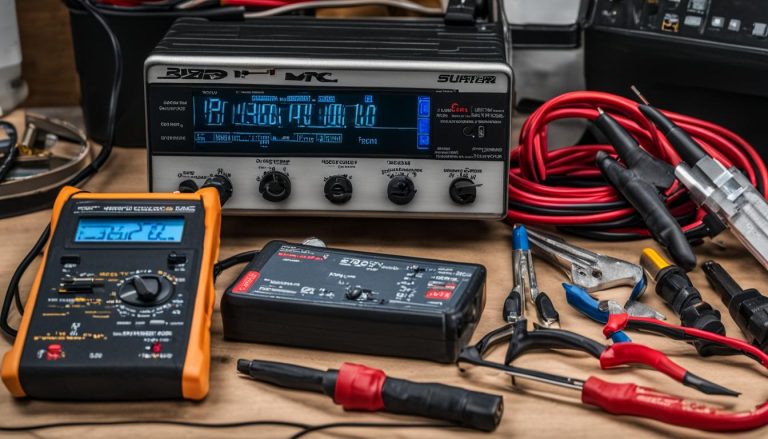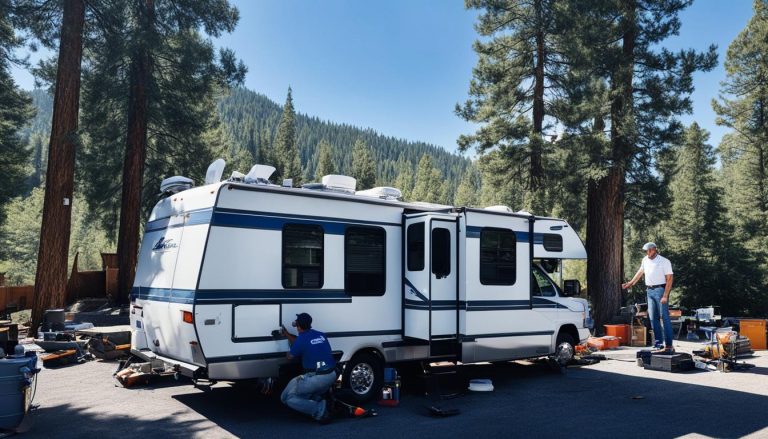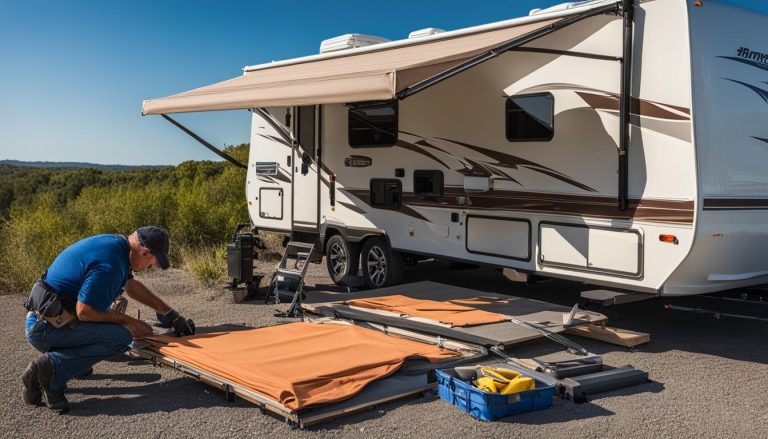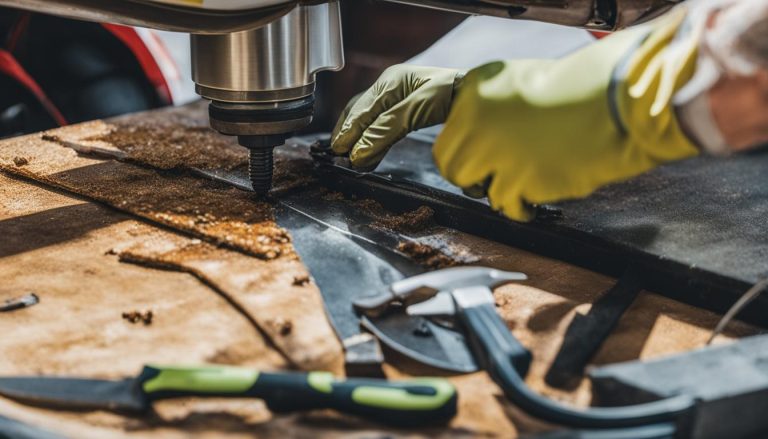Empty Your RV Septic Tank Easily & Safely
gorvlifestyle.com and its partners may earn a commission if you purchase a product through one of our links
Dumping your RV septic tank is an essential part of RV maintenance. Properly emptying and maintaining your septic tank is not only important for a clean and odor-free RV experience but also for avoiding potential issues down the road. In this article, we will guide you on how to empty your RV septic tank safely and efficiently, whether you choose to do it at home or at a dump station.
Key Takeaways:
- Check local laws and regulations before emptying your RV septic tank at home.
- There are three methods for emptying your RV tanks at home: the bucket method, macerating, and dumping into a cleanout port.
- Using bacteria and enzyme treatments in your holding tanks can help preserve the bacteria in your septic tank or the city treatment plant.
- Dumping at home can save you money on dump station fees and provide more convenience.
- Properly emptying your tanks requires following a step-by-step process and taking preventative measures to avoid clogs.
Benefits of Dumping RV Holding Tanks at Home
Dumping your RV holding tanks at home can provide several advantages, making it a convenient option for many RV owners. Here are the benefits of emptying your tanks at home:
Firstly, it allows you to avoid the dumping fees that may be charged at dump stations. By saving money on these fees, you can put it towards other aspects of your RV adventure.
Secondly, emptying your tanks at home enables you to skip the lines and potential wait times often experienced at busy dump stations. This means you can get on with your journey without unnecessary delays.
Additionally, dumping at home helps you avoid making an extra stop on your way back from your trip. This can be particularly convenient if you are eager to get home quickly and avoid any detours.
Another benefit is that dumping at home gives you more control over the process. You can take your time to properly empty and clean the tanks without feeling rushed or pressured by others waiting in line.
Dumping your RV holding tanks at home provides a cost-effective, time-saving, and stress-free solution, allowing you to maintain RV sanitation and septic tank cleaning in a convenient way. Take advantage of these benefits and enjoy a smoother RV experience.
The Bucket Method for Dumping RV Tanks
The bucket method is a simple and effective way to empty your RV holding tanks, especially if you only have a small amount of waste. This method can be particularly useful when you don’t have access to a dump station or if you prefer emptying your tanks at home. Here’s how you can use the bucket method:
- First, gather the necessary supplies:
- A 5-gallon bucket
- Disposable rubber gloves (optional)
- A wide-mouthed funnel (optional)
Benefits of the Bucket Method
The bucket method offers several advantages for emptying RV tanks:
- Simplicity: The bucket method is straightforward and doesn’t require any specialized equipment.
- Flexibility: You can use the bucket method anywhere, making it a convenient option for off-grid camping or when dump stations are unavailable.
- Cost-effectiveness: Since the bucket method doesn’t rely on dump stations, it helps you save money on dumping fees.
- Control: By manually emptying your tanks, you have greater control over the process and can ensure that the waste is disposed of properly.
The bucket method is a reliable solution for emptying your RV holding tanks, especially when you need to empty them quickly or without access to traditional dump stations. It offers simplicity, flexibility, and cost-effectiveness while allowing you to take charge of managing your RV sewer system.
The Macerating Method for Dumping RV Tanks
The macerating method is an effective way of emptying your RV tanks, especially when dealing with larger amounts of waste. This method involves utilizing a special pump called a macerator, which crushes the waste into a smoothie-like consistency. The macerator pump is connected to a garden hose, allowing you to channel the macerated waste into your home’s septic tank or cleanout port.
The advantages of the macerating method are twofold. Firstly, it helps break down the waste in the septic tank more efficiently, promoting better decomposition. Secondly, by dumping the macerated waste into the cleanout port rather than the toilet, you can avoid potential mess and clogs.
If you’re unsure about how to perform the macerating method, follow these steps:
- Connect the macerator pump to a garden hose.
- Position the macerator pump near the discharge line.
- Open the RV tank valves and allow the waste to flow into the macerator pump.
- Turn on the macerator pump to crush the waste.
- Direct the macerated waste through the garden hose and into your home’s septic tank or cleanout port.
- Repeat the process until your RV tanks are fully emptied.
Using the macerating method for dumping your RV tanks can streamline the waste disposal process and ensure more effective septic tank maintenance. Remember to follow safety precautions and wear gloves when handling waste, and always dispose of waste in accordance with local laws and regulations.
Steps for Properly Emptying RV Holding Tanks
Properly emptying your RV holding tanks requires a step-by-step process to ensure a clean and efficient disposal. Follow these simple steps to effectively empty your tanks:
- Locate the sewer hookup at your dumping location and connect a water hose to a freshwater supply.
- Put on disposable gloves to protect your hands, and retrieve your sewer hose. Check that the fittings are secure.
- Connect the sewer hose to the dump tank spout and use a sewer hose support to create a natural gradient for waste flow.
- Identify the handles for your black water and gray water tanks. It is important to always dump the black water first, followed by the gray water.
- Open the black water tank handle and allow the waste to flow out completely. Take your time to ensure thorough emptying.
- Once the black water tank is empty, close the black water handle and open the gray water handle to empty the gray water tank.
- Perform a preliminary freshwater flush by using a hose to rinse the inside of the tank. If available, use a black water tank flush for a more thorough cleaning.
- Close the handles for both the black water and gray water tanks, ensuring a secure seal.
- Clear the sewer hose by slowly removing it from the dump tank spout, allowing any remaining waste to flow into the sewer hookup. Be careful not to spill any waste.
- Disconnect the sewer hose from the dump tank spout and rinse it thoroughly with clean water.
- Do a final rinse of the sewer hose and dump tank spout to ensure cleanliness.
- Wash your hands with soap and water, or use hand sanitizer, to maintain proper hygiene after handling waste.
By following these steps, you can effectively and safely empty your RV holding tanks, maintaining proper sanitation and preventing any potential issues. Remember to always dispose of waste responsibly and follow local regulations.
Tips for Preventing Clogs in RV Holding Tanks
To prevent clogs in your RV holding tanks, there are a few tips to keep in mind. By following these guidelines, you can maintain a smooth and hassle-free RV waste disposal system.
1. Use thin, septic-safe toilet paper
Using thin, septic-safe toilet paper is essential for preventing clogs in your RV holding tanks. Thick or non-septic-safe toilet paper can accumulate and cause blockages in the plumbing system. Opt for RV-specific toilet paper that is designed to break down easily in the tank.
2. Consider using waste tank drop-in packs
Waste tank drop-in packs are convenient and effective for breaking down solids and deodorizing your black tank. These packs contain special enzymes and bacteria that help break down waste, making it easier to empty your tanks and preventing clogs.
3. Avoid rinsing grease or animal fat down your sink drain
Grease and animal fat solidify when they cool down, leading to clogs in your kitchen sink and gray tank. To prevent this, avoid rinsing greasy dishes or pouring animal fat down the sink drain. Instead, wipe excess grease with paper towels and dispose of them in the trash.
4. Be mindful of what goes down your drains
Preventing clogs in your RV holding tanks also requires being mindful of what goes down your drains. Avoid disposing of large food particles, coffee grounds, or non-biodegradable items down the sink or toilet. Stick to eco-friendly soaps that dissolve easily and help keep your gray tank clean.
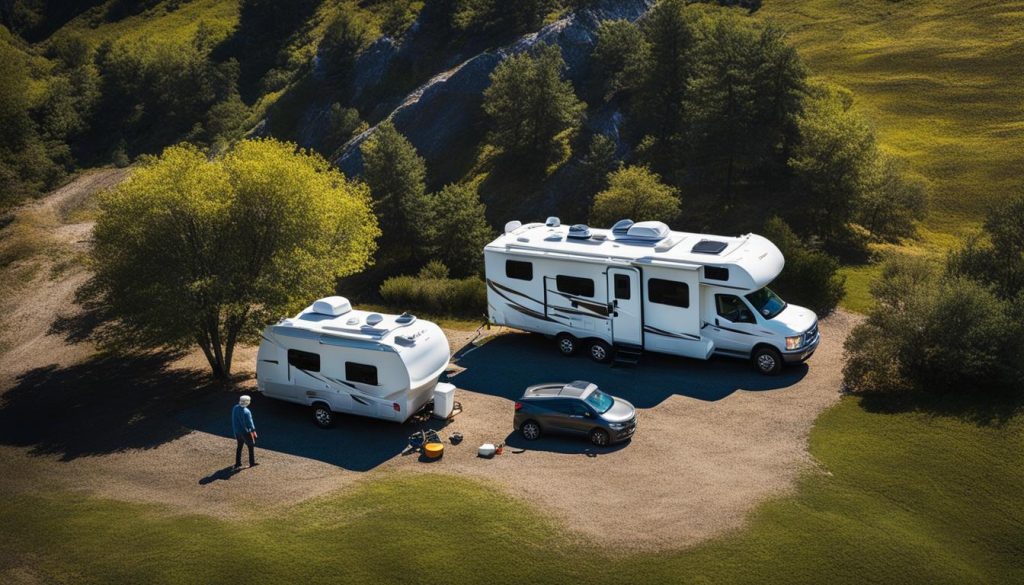
Following these tips will help you maintain a clog-free RV waste disposal system and ensure a smooth and worry-free RVing experience.
Finding Dump Stations for RV Waste Disposal
When you are on the road with your RV, finding dump stations for waste disposal is essential. Luckily, there are several resources available to help you locate these convenient facilities. Websites like SaniDumps.com, Campendium, and RVDumps.com can assist you in finding dump stations near your current or planned destination. Simply input your location or zip code, and these websites will provide you with a list of nearby dump stations.
Dump stations are shared spaces, so it’s important to be considerate of others and follow proper etiquette. When using a dump station, make sure to leave the area clean and tidy for the next user. Some dump stations may also have trash receptacles, allowing you to conveniently dispose of any additional waste.
Remember, dumping your RV waste properly not only helps you maintain a clean and odor-free environment but also contributes to the overall sanitation of RV camping areas. So, be a responsible RVer and make use of dump stations when you need to empty your RV tanks.
Tips for Finding Dump Stations:
- Use websites like SaniDumps.com, Campendium, and RVDumps.com to locate dump stations
- Search by location or zip code to find dump stations near your destination
- Check for dump stations at RV parks, campgrounds, or rest areas
- Consider downloading RV-specific apps that provide information on dump stations
| Website | Description |
|---|---|
| SaniDumps.com | A comprehensive database of dump stations across the United States |
| Campendium | An RV camping website that includes dump station locations and reviews |
| RVDumps.com | A user-friendly platform for finding dump stations with detailed information |
“Finding dump stations for RV waste disposal is crucial for maintaining a clean and sanitary camping experience.”
Next, let’s explore the process of properly emptying your RV holding tanks and some helpful tips for preventing clogs.
Conclusion
Properly maintaining your RV septic tank is essential for a clean and odor-free RV experience. Whether you choose to empty your tanks at home or at a dump station, following the correct steps outlined in this article will ensure a smooth and safe process. By regularly emptying your tanks and taking preventative measures to avoid clogs, you can maintain a healthy and efficient RV sewer system.
Remember to always check the local laws and regulations before emptying your tanks at home to avoid any legal issues. It is also recommended to use bacterial and enzyme treatments to preserve the bacteria in your septic tank or the city treatment plant. These treatments aid in the breakdown of waste and promote a healthy environment in your RV.
By implementing proper RV septic tank maintenance practices, you can enjoy worry-free travels and a pleasant camping experience. Taking care of your RV’s sanitation needs not only benefits you but also helps to protect the environment. So, keep these tips in mind and enjoy your adventures knowing that your RV’s septic system is in top-notch condition!
FAQ
How do I empty my RV septic tank?
There are three major methods for emptying your RV’s tanks at home: the bucket method, macerating, and dumping directly into a cleanout port. It is important to use caution and check local laws and regulations before emptying your tanks at home. Stick to bacteria and enzyme treatments in your holding tanks to avoid disrupting the bacteria in your septic tank or the city treatment plant.
What are the benefits of dumping RV holding tanks at home?
Dumping your RV holding tanks at home allows you to avoid dump station fees, skip lines and potential wait times, and have more control over the process. It is particularly convenient if you want to get home quickly after a trip.
How do I use the bucket method to empty my RV tanks?
To use the bucket method, you will need a 5-gallon bucket, disposable rubber gloves (optional), and a wide-mouthed funnel (optional). Place the bucket under the discharge line, open the valve slowly to fill the bucket with waste, and then pour the waste into your home’s septic tank or cleanout port. Repeat until your gray or black water tank is empty.
How does the macerating method work for emptying RV tanks?
The macerating method involves using a special pump called a macerator to crush the waste into a smoothie-like consistency. The macerator pump is connected to a garden hose, and the macerated waste can be channeled into your home’s septic tank or cleanout port. Dumping the macerated waste into the cleanout port is recommended to avoid potential mess and clogs.
What are the steps for properly emptying RV holding tanks?
First, locate the sewer hookup, connect a water hose to a freshwater supply, and check that the fittings are secure. Put on disposable gloves, retrieve your sewer hose, and connect it to the dump tank spout. Dump the black water tank first, followed by the gray water. Perform a preliminary freshwater flush and use a black water tank flush if available. Close the handles, clear the hose, and disconnect it. Finally, do a final rinse and wash up to complete the process.
How can I prevent clogs in my RV holding tanks?
To prevent clogs, use thin, septic-safe toilet paper and consider using waste tank drop-in packs. Avoid rinsing grease or animal fat down your sink drain and be mindful of what goes down your drains. Using eco-friendly soaps can help dissolve food and clean your gray tank.
Where can I find dump stations for RV waste disposal?
You can find dump stations near your location or planned destination using websites like SaniDumps.com, Campendium, and RVDumps.com. These websites allow you to search by location or zip code to locate the nearest dump stations.
How do I properly empty and maintain my RV septic tank?
Whether you choose to dump your tanks at home or at a dump station, following the proper steps outlined in this article will ensure a smooth and safe process. Regularly empty your tanks and take preventative measures to avoid clogs. Always check local laws and regulations before emptying your tanks at home and consider using bacterial and enzyme treatments to preserve the bacteria in your septic tank or the city treatment plant.



